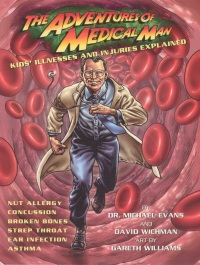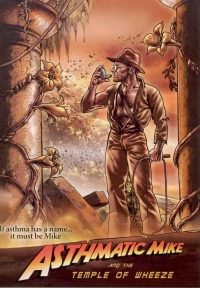| ________________
CM . . . . Volume XVII Number 10. . . .November 5, 2010. 
 |
The Adventures of Medical Man: Kids Illnesses and Injuries Explained.
Michael Evans and David Wichman. Art by Gareth Williams.
Toronto, ON: Annick Press, 2010.
72 pp., pbk. & hc., $12.95 (pbk.), $21.95 (hc.).
ISBN 978-1-55451-262-1 (pbk.), ISBN 978-1-55451-263-8 (hc.).
Subject Headings:
Diseases-Juvenile literature.
Wounds and injuries-Juvenile literature.
Medicine-Juvenile literature.
Grades 6-8 / Ages 11-13.
Review by Gail Hamilton.
**½/4
|
| |
|

excerpt:
The sapling I had seen revealed itself to be one of a family that framed a clearing at the top of the bank. There I built a fire to keep young Lucy warm and to give me better light by which to work. Carefully I pulled back the sleeve of her tunic and examined the offended limb. By the light of the fire I could see that the arm was swollen near the elbow. Fortunately there was no blood, the scent of which I feared would draw the beast. Upon my inquiring as to her sensations, she admitted to considerable discomfort and a feeling of pins and needles pricking her fingers. And indeed, those phalanges responded with little movement when she tried to move them.
Designed to demystify some common childhood illnesses and injuries, this book features superhero Dr. Mike Evans who stars in five “motion pictures” and a comic book. Following a brief introduction, there are 11 chapters devoted to six medical conditions: a nut allergy, concussion, broken bones, strep throat, an ear infection and asthma, although the nut allergy gets the lion’s share of text. A full page movie poster introduces each topic. Within each story is imbedded factual information about the causes, symptoms and cures for the conditions. Sidebars and anatomical diagrams condense the information and supplement the narrative. “They Came from Mars!” is a serial about alien invaders-allergens- that attack the human body. Typical of TV serials, there are questions posed at the end of each of the six episodes- “Is Earth earmarked for annihilation by an alien army of oversized arachnids? Can our trio triumph over extraterrestrial tyranny?” Concussion is highlighted in “The Case of the Dizzy Dame” which pays homage to the lantern-jawed gumshoes of the mid-1900s. Readers who are familiar with this genre- the private investigator novel/movie/TV show- will be able to “hear” the voice of the PI via the style of the text. Evans changes his writing style yet again in “The Werewolf Who Snapped”, a Gothic mystery reminiscent of Dr. Jekyll’s England in both its eerie setting and use of language. In this chapter, readers will learn about the various types of fractures, how they are diagnosed and casted, and how they heal. A comic book is devoted to the topic of strep throat in “The Adventures of Medical Man and Wondrous Boy”. Information includes the ways in which doctors determine whether the patient has strep throat, the body’s ability to heal itself, and at what point there is a need for pharmaceutical intervention. At the end of the chapter, Charles Abscess, M.D. appears. This muscleman, akin to Charles Atlas, the famous bodybuilder of long ago, explains the use of antibiotics in the treatment of bacterial infections. “The Hurt from Red Eardrum”, a play on the movie “The Hunt for Red October”, describes what happens when a child develops an ear infection. It even takes place aboard a submarine, as did the action in the original movie. Finally, “Asthmatic Mike and the Temple of Wheeze” features an Indiana Jones look-alike, complete with hat and whip (but with the addition of a puffer). Objects from the Indiana Jones movies are incorporated into the action- a rolling dust ball the size of a truck, stone portals and booby traps, to name a few. In this chapter is information about respiration and the causes of asthma, as well as the difference between the two types of inhalers used to treat the condition.
 Kudos to the real Dr. Michael Evans, the book’s author, for attempting to explain illnesses and diseases in a creative and unique manner, and for changing his writing style to suit the various movie genres. However, the book falls short in several ways. Firstly, there is too much emphasis on allergies, and the six episodes being presented alternately with other topics creates a bit of a disjointed feeling. Secondly, the placement of the additional text boxes and diagrams interrupts the flow of the main body of the text. Thirdly, readers who are really interested in finding out about childhood diseases and injuries have to sift through a large amount of text in order to obtain the facts. (One also wonders why Dr. Evans did not include any information about other childhood diseases such as chicken pox and measles.) Finally, the targeted audience might be too young to fully understand some of the subtle humour, for example, the references to Charles Atlas (who died in 1972), General George Patton (who died in 1945), black-and-white private eye TV shows, or even The Hunt for Red October, which was in theaters 20 years ago. Kudos to the real Dr. Michael Evans, the book’s author, for attempting to explain illnesses and diseases in a creative and unique manner, and for changing his writing style to suit the various movie genres. However, the book falls short in several ways. Firstly, there is too much emphasis on allergies, and the six episodes being presented alternately with other topics creates a bit of a disjointed feeling. Secondly, the placement of the additional text boxes and diagrams interrupts the flow of the main body of the text. Thirdly, readers who are really interested in finding out about childhood diseases and injuries have to sift through a large amount of text in order to obtain the facts. (One also wonders why Dr. Evans did not include any information about other childhood diseases such as chicken pox and measles.) Finally, the targeted audience might be too young to fully understand some of the subtle humour, for example, the references to Charles Atlas (who died in 1972), General George Patton (who died in 1945), black-and-white private eye TV shows, or even The Hunt for Red October, which was in theaters 20 years ago.
The illustrations are reminiscent of comic books are largely rendered in sepia tones with other colours occasionally used as accents. A brief list for further reading, a glossary with pronunciations provided, and an index are included.
Though this book is cleverly written and has some merit, the combination of fact and fiction might limit the number of readers who check out the book from the library. Those who strictly want the facts will head to the health section, and those who desire a Gothic mystery or a science fiction book, for example, will head to the fiction shelves.
Recommended with reservations.
Gail Hamilton is a retired teacher-librarian in Winnipeg, MB.

To comment on this title or this review, send mail to
cm@umanitoba.ca.
Copyright © the Manitoba Library Association. Reproduction for personal use is permitted only if this copyright notice is maintained. Any other reproduction is prohibited without permission.
NEXT REVIEW |
TABLE OF CONTENTS FOR THIS ISSUE- November 5, 2010.
AUTHORS |
TITLES |
MEDIA REVIEWS |
PROFILES |
BACK ISSUES |
SEARCH |
CMARCHIVE |
HOME |

 Kudos to the real Dr. Michael Evans, the book’s author, for attempting to explain illnesses and diseases in a creative and unique manner, and for changing his writing style to suit the various movie genres. However, the book falls short in several ways. Firstly, there is too much emphasis on allergies, and the six episodes being presented alternately with other topics creates a bit of a disjointed feeling. Secondly, the placement of the additional text boxes and diagrams interrupts the flow of the main body of the text. Thirdly, readers who are really interested in finding out about childhood diseases and injuries have to sift through a large amount of text in order to obtain the facts. (One also wonders why Dr. Evans did not include any information about other childhood diseases such as chicken pox and measles.) Finally, the targeted audience might be too young to fully understand some of the subtle humour, for example, the references to Charles Atlas (who died in 1972), General George Patton (who died in 1945), black-and-white private eye TV shows, or even The Hunt for Red October, which was in theaters 20 years ago.
Kudos to the real Dr. Michael Evans, the book’s author, for attempting to explain illnesses and diseases in a creative and unique manner, and for changing his writing style to suit the various movie genres. However, the book falls short in several ways. Firstly, there is too much emphasis on allergies, and the six episodes being presented alternately with other topics creates a bit of a disjointed feeling. Secondly, the placement of the additional text boxes and diagrams interrupts the flow of the main body of the text. Thirdly, readers who are really interested in finding out about childhood diseases and injuries have to sift through a large amount of text in order to obtain the facts. (One also wonders why Dr. Evans did not include any information about other childhood diseases such as chicken pox and measles.) Finally, the targeted audience might be too young to fully understand some of the subtle humour, for example, the references to Charles Atlas (who died in 1972), General George Patton (who died in 1945), black-and-white private eye TV shows, or even The Hunt for Red October, which was in theaters 20 years ago.